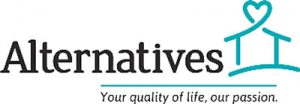December 29, 2017
Transition Coordination – an introduction

 By Brycie Wilson
By Brycie Wilson
Alternatives for the Older Adult
Program Director and
Transition Coordinator
For the third time this winter, Mom is in the hospital. No sooner did she get settled back home following hospitalization for COPD (Chronic Obstructive Pulmonary Disease), she then contracted pneumonia and earned yet another ambulance ride to the emergency department. Mom is frustrated, Dad feels helpless and their adult children living nearby are not sure where to turn next. There’s the family physician, the lung specialist, the hospitalist, the hospital staff, the pharmacist and the family all touching on their “piece” of the situation and sometimes at odds with each other.
It’s an all too common scenario and a cycle begging to be broken; hence the need for Transition Coordination. Transition Coordination pulls these puzzle pieces together into an integrated plan. A successful transition, then, is one where the individual does not re-admit to the hospital or skilled nursing facility for the same issues that caused the first admission.
According to Medicare.gov, nearly one in five Medicare patients discharged from a hospital are readmitted within 30 days. That is approximately 2.6 million seniors at a cost of over $26 billion annually. Many factors contribute to these numbers including; communication errors, medication errors, lack of supports at home or delays in scheduling post-discharge care. Frequently, individuals readmit for the same chronic conditions such as Chronic Obstructive Pulmonary Disease, Congestive Heart Failure or Diabetes.
For hospitals, staff are mindful of educating the individual and family about the diagnosis and preparing for any skilled needs as part of a discharge plan. However, it is difficult for this information to transfer into the home environment. Either the individual “just wants to go home” and didn’t listen to the discharge plan, or they don’t have the home environment or natural supports to follow through with the discharge plan. Research shows that between 40-50 percent of readmissions to the hospital were related to psycho-social problems (non-medically related) and lack of community support resources.
Alternatives’ Transition Coordinators provide a bridge from hospital to home or from skilled nursing to home. They meet with the individual at the hospital prior to discharge to review resources, services and supports. Beyond the Medicare-covered home health services traditionally offered such as a visiting nurse, bath aid, and/or physical, occupational and/or speech therapy, Transition Coordinators assist to set up home-delivered meals, adult day services, homemaker services for cleaning and laundry, emergency home response, medication reminders, or other assistive devices.
Once home, Alternatives’ Transition Coordinators follow up with the individual to assure supports are in place and assess for other needs such as home modifications, transportation to medical appointments or medication review. This follow-up can be ongoing for up to 90 days after the discharge to assure critical needs are being met and to prevent health decline.
Navigating the discharge process and knowing what Mom is going to need before returning home can be tricky. However, with the involvement of a Transition Coordinator bridging the hospital setting to home, there’s a good chance Mom will return home with adequate support to avoid a
fourth and costly hospital visit this season. If you know of someone experiencing frequent hospital visits, give Alternatives a call to help navigate a more successful plan going forward. We all benefit.
Filed Under: Community, Health & Wellness
Trackback URL: https://www.50pluslife.com/2017/12/29/transition-coordination-an-introduction/trackback/


